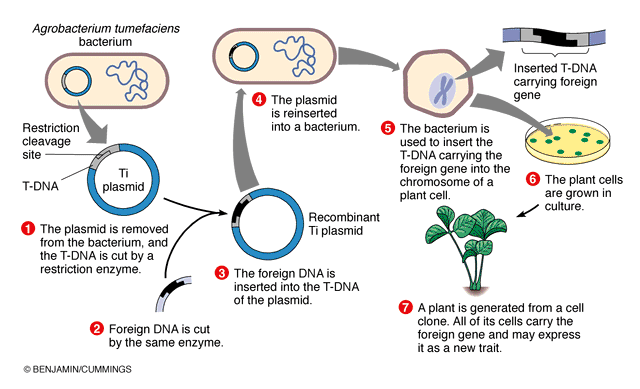Which Organism Is Most Commonly Used in Genetic Engineering
4 rows Additionally which bacteria is most useful in genetic engineering. The organism that receives the recombinant DNA is called a genetically modified organism GMO.

How Are Organisms Genetically Modified
GMO which stands for Genetically Modified Organism is the organism that is created using the modified gene.

. The addition of foreign DNA in the form of recombinant DNA vectors generated by molecular cloning is the most common method of genetic engineering. Corn cattle and even dogs have been selectively bred over generations to have certain desired traits. Most recombinant DNA technology involves the insertion of foreign genes into the plasmids small rings of DNA of common laboratory strains of bacteria.
A genetically modified organism GMO is an animal plant or microbe whose DNA has been altered using genetic engineering techniques. The most commonly used mechanism for introducing engineered plasmids into a bacterial cell is transformation a process in which bacteria take up free DNA from their surroundings. Till today the most.
If the foreign DNA that is introduced comes from a different species the host organism is called transgenic. One of the benefits that come out of GMOs is scientists are able to produce genetically modified foods. Methods of Genetic Engineering-There are three main methods through which genetic engineering techniques work.
Ii Hormone somatostatin is also produced within the bacterium E. Genetically modified mice are the most common genetically engineered animal model. In 1973 scientists Herbert Boyer and Stanley Cohen used a plasmid to insert a gene.
How does transformation occur in eukaryotes. Genetically modified mice have been the most common mammals used in biomedical research as they are cheap and easy to manipulate. Plasmid method occurs in the following way.
A small circular piece of DNA found naturally in bacteria. In the laboratory free DNA in the form of recombinant plasmids is introduced to the cells surroundings. A new strain of bacteria could easily be created with genetic engineering given the advent of synthetic biology.
Usually Agrobacterium tumefaciens has to be used for GM plants. Bacterial genetic variations take place through this method. The process of crossing individuals which are genetically related to each other producing offspring genetically similar to the parents example AKC dog breeds plasmid.
What Bacteria Is Most Commonly Used In Genetic Engineering. By removing the DNA from plants the new plant will have a DNAase installed. The Plasmid Method-Plasmid method is the most commonly used method of altering the genes of any microorganism.
For thousands of years humans have used breeding methods to modify organisms. Understanding a VPS for Beginners. Pigs are also a good target as they have a similar body size and anatomical features physiology pathophysiological response and diet.
Artificial gene manipulation is known as genetic engineering. In 2020 scientists cloned the endangered black-footed ferret. What type of organism was the first to be successfully modified via the techniques of genetic engineering.
When infected by bacillus infectiphage recombinant DNA can be carried into bacterial cells in numbers typically not seen before. While the ethics of cloning are hotly debated the first-ever sheep named Dolly was cloned in 1996 by scientists. However only in the past two decades has the ability of Agrobacterium to transfer DNA to plant cells been harnessed for the purposes of plant genetic engineering.
Foreign proteins as soon as you infect it. Coli was discovered today in the US. The bacterium Escherichia coli is widely used in genetic engineering experiments as.
The introduced DNA will then insert itself into the cells DNA during a replication stage. Polymerase Chain Reaction PCR a technique used to make more copies of a sequence of DNA. Eg the DNA being inserted into the.
Several organisms in biotechnology and genetic engineering are important including E. I Human insulin chains α and β chains are synthesized within the E. One of the most controversial uses of genetic engineering has been cloning or producing a genetically identical copy of an organism.
They have been used to study and model cancer the oncomouse obesity heart disease diabetes arthritis substance abuse anxiety aging and Parkinson disease. Today roughly about 80 of the food we consume has been genetically modified. There is also some form of salmonella omebacterium tumefaciens.
Agrobacterium tumefaciens and related Agrobacterium species have been known as plant pathogens since the beginning of the 20th century. It is largely the lactic acid bacteria which produce food for us that scientists have gone out of the business of genetically engineering bacteria in the food industry. Through gene transfer bacteria are then transferred DNA to the plants genomes and the bacteria then infect plants with new genes.
Since about a third of the virus genome is considered nonessential it will be removed and replaced with foreign DNA ie. Genetic engineering is also used to create animal models of human diseases. Various types of bacteria provide for genetic engineering experiments but e coli E and riboflavin R represent two of the most important strains.
Gene _____ are commonly used for identifying bacteria or viruses in an unknown culture and diagnosing causative agents of infection. The use of viruses to inject in the DNA or liposomes to release DNA into the cell cytoplasm occurs. What is heat shock treatment.
Since the initial reports in the early 1980s using Agrobacterium to. Which Bacteria Is Most Commonly Used In Genetically Modified Plants. How YouTube Has Made Understanding Tech More Accessible.
In nature free DNA typically comes from other lysed bacterial cells.

600 Published Safety Assessments Plant Breeding Genetic Engineering Genetics

Genetic Engineering 20 2 1 Cie Igcse Biology Revision Notes 2020 Save My Exams

No comments for "Which Organism Is Most Commonly Used in Genetic Engineering"
Post a Comment